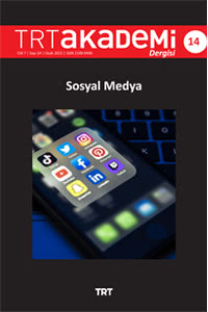Dijitalden Tatmak: Yemeğin “Yeni” Gastro Mekanlardaki Seyirlik Gösterisinin Kültürel Yansımaları
Yemek kültürü, gastromedya, sosyal medya, tüketim kültürü, popüler kültür
Tasting From The Digital: Cultural Reflections of Foods’ Spectacle In The “New” Gastro Places
Food Culture, Gastromedia, Social Media, Consumption Culture, Popular Culture,
___
- KaynakçaBanerji, R., & Maheshwari, R. (2015, 12 9). Deloitte. 04 22, 2018 tarihinde https://www2.deloitte.com/content/dam/Deloitte/in/Documents/technology-media-telecommunications/in-tmt-rise-of-on-demand-content.pdf adresinden alındıBarthes, R. (1964). Elements of Semiology . New York : Hill and Wang.Barthes, R. (1979). Towards a Psychosociology of Contemporary Food Consumption. R. Forster, & O. Ranum içinde, Food and Drink in History (s. 166-173). Baltimore: Johns Hopkins University Press.Barthes, R. (1997). Toward a Psychosociology of Contemporary Food Consumption . C. Counihan, & P. Van Esterik içinde, Food and Culture: A Reader (s. 20-27). New York: Routledge.Barthes, R. (2008). Toward A Psychosociology of Contemporary Food Consumption. C. Counihan, & P. Van Esterik içinde, Food and Culture (s. 22-24). New York: Routledge.Baudrillard, J. (2002). Tüketim Toplumu. İstanbul: Ayrıntı Yayınları.Castells, M. (2001). The Internet Galaxy: Reflections on the Internet, Business and Society. Oxford: Oxford University Press.Chamberlain, K. (2004). Food and Health: Expanding the Agenda for Health Psychology. Journal of Health Psychology, 467–481.Debord, G. (1995). Society of the Spectacle. . New York: Zone Books.Deloitte. (2014, 11 02). Social Media and the Digital Enterprise. 04 26, 2018 tarihinde Deloiitte: https://www2.deloitte.com/content/dam/Deloitte/us/Documents/risk/us-aers-social-media-digital-enterprise-100314.pdf adresinden alındıFischler, C. (1988). Food, Self and Identity. Social Science Information, 275-292.Gronow, J. (1997). A sociology of taste. New York: Routledge.Hine, C. (2000). Virtual Ethnography. California: Sage Publications.Ibrahim, Y. (2011). The non-stop 'capture': The politics of looking in postmodernity. The Poster, 1(2), 167-185.Janet, C. (2004). Slow Food: What, Why, and to Where? . Food, Culture & Society , 117-132.Kanık, İ. (2016). Gastro Gösteri. İstanbul: Ayrıntı Yayınları.Katz, J., & Rice, R. (2002). Social Consequences of Internet Use . Cambridge: Mit Press.Kollock, P., & Smith, M. (1999). Communities in Cyberspace. New York: Routledge.Levi-Strauss, C. (1983). The Raw and the Cooked: Mythologiques Volume One. Chicago: University of Chicago Press.McLuhan, M. (1962). Gutenberg Galaksisi. (G. Güven Çağalı, Çev.) İstanbul: Yapı Kredi Yayınları.Montanari, M. (2006). Food Is Culture. New York: Columbia University Press.Onaran, b. (2016). Mutfak Tarih: Yemeğin Politik Serüvenleri. İstanbul: İletişim Yayınları.Parasecoli, F. (2008). Bite Me. Food In Popular Culture . New yORK: Berg.Pew Research Center. (2013, 10 28). Video and Photo Sharing Grow Online’ Pew Research Centre. 04 22, 2018 tarihinde http://www.pewinternet. org/2013/10/28/photo-and-video-sharing-grow-online/ adresinden alındıRousseau, S. (2012). Food And Social Media: You Are What You Tweet. Maryland: Altamira Press.Rousseau, S. (2014). Food "Porn" in Media. D. M. Kaplan içinde, Encyclopedia of Food and Agricultural Ethics (s. 1-8). Netherlands: Springer.Scholliers, P. (2001). Food, Drink and Identity: Cooking, Eating and Drinking in Europe since the Middle Ages. Oxford: Berg.Stroer Kentvizyon. (2017, 03 09). Stroer Kentvizyon. 04 22, 2018 tarihinde http://www.stroer.com.tr/arastirma/impacto/medyatuketimi adresinden alındıThanarugchok, N. (2017). “Beyond Appetite”: Examining Identities and Motivations of Foodies through Food Visuals on Instagram. Seattle: University of Washington.Tylor, E. B. (1871). Primitive culture: Researches into the development of mythology, philosophy, religion, art, and custom. London: John Murray.Warde, A. (2016). The Practice of Eating . Cambridge: Polity Press.Warde, A., & Martens, L. (2000). Eating Out: Social Differentiation, Consumption and Pleasure . Cambridge: Cambridge University Press.Wellman, B. (2004). Connetcting Communities: On and Offline. Contexts, 22-28.
- ISSN: 2149-9446
- Yayın Aralığı: 3
- Başlangıç: 2016
- Yayıncı: TRT
Post Truth Çağında Yayıncılığın Geleceği
Dinsel söylem yok olmuyor, medyatikleşiyor
Kullanımlar ve Doyumlar Yaklaşımı Çerçevesinde Y Kuşağının WhatsApp Kullanımı Üzerine Bir İnceleme
Mihrican TEPE, Aşina GÜLERARSLAN ÖZDENGÜL
Gösteriden Yeniden Üretime Televizyonda Yayımlanan Şaka Programları
Gündelik “C Vitamininzi" aldınız mı? Peki ya, gündelik “ekranınızı?”
Mahremiyetin ihlalinden değil, aksine gönüllü bir ifşadan söz edilebilir
Orta Sınıf Olma Komedisi: Little Britain ve Vicky
GÖSTERİDEN YENİDEN ÜRETİME TELEVİZYONDA YAYINLANAN ŞAKA PROGRAMLARI
